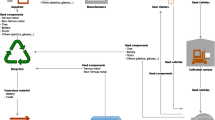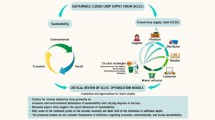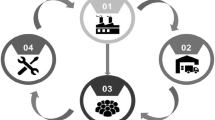Abstract
In global industry supply chains, environmental sustainability optimization addresses the overall consumption of resources and energy, the reduction of carbon emissions and generated waste to name a few. In this paper, we propose a holistic sustainability optimization framework for strategic network design of industry supply chains under consideration of economic, social as well as ecologic objectives. The framework is flexible to incorporate multiple sustainability indicators, alternative sustainability optimization strategies as well as a variety of internal and external industry-specific factors which impact the sustainability of the entire industry supply chain in the long-term. The core of the framework is an end-to-end closed-loop value chain model consisting of process, transport and product-in-use modules. For the first time, the product-in-use impact (“use” vs. “make”) is integrated in one network design approach. In addition, the model fully closes the loop from sourcing of raw materials via manufacturing towards reverse value chain steps such as disposal and recycling. Finally, we propose the minimize-time-to-sustainability approach as new optimization strategy for long-term network design problems focusing on minimizing the time, industry supply chain structures need to transform into sustainability steady states for all defined sustainability indicators such as CO2e emissions, costs or social indicators based on defined target values. In part 2 of this paper the application of the optimization framework to the European automotive industry is shown.







Similar content being viewed by others
References
Abdallah T, Diabat A, Simchi-Levi D (2012) Sustainable supply chain design: a closed-loop formulation and sensitivity analysis. Prod Plan Control 23(2–3):120–133
Ballot E, Fontane F (2010) Reducing transportation CO2 emissions through pooling of supply networks: perspectives from a case in French retail chains. Prod Plan Control 21(6):640–650
Chaabane A, Ramudhin A, Paquet M (2011) Designing supply chains with sustainability considerations. Prod Plan Control 22(8):727–741
Chaabane A, Ramudhin A, Paquet M (2012) Design of sustainable supply chains under the emission trading scheme. Int J Prod Econ 135(1):37–49
Diabat A, Simchi-Levi D (2009) A carbon-capped supply chain network problem. In: Proceedings of the IEEM, international conference on industrial engineering and engineering management, pp 523–527
Elkington J (1998) Cannibals with forks: the triple bottom line of 21st century business. New Society Publishers, Stoney Creak
Garetti M, Taisch M (2012) Sustainable manufacturing: trends and research challenges. Prod Plan Control 23(2–3):83–104
Goetschalckx M, Fleischmann B (2008) Strategic network planning. In: Stadtler H, Kilger C (eds) Supply chain management and advanced planning, 4th edn. Springer, Berlin, pp 117–132
Greenhouse Gas Protocol (2004) A corporate accounting and reporting standard, Revised edition. World Resources Institute and World Business Council for Sustainable Development, USA
Greenhouse Gas Protocol (2011) Corporate value chain (Scope 3) accounting and reporting standards. World Resources Institute and World Business Council for Sustainable Development, USA
Günther H-O, Kannegiesser M (2010) The impact of CO2 regulations on transportation in supply chains. In: Sumalee A, Lam WHK, Ho HW, Siu B (eds) Transportation and urban sustainability. Hong Kong Society for Transportation Studies, Hong Kong, pp 537–544
Harris I, Naim M, Palmer A, Potter A, Mumford C (2011) Assessing the impact of cost optimization based on infrastructure modelling on CO2 emissions. Int J Prod Econ 131(1):313–321
IISD (International Institute for Sustainable Development) (1992) Business strategy for sustainable development: leadership and accountability for the 90s. Diane Pub. Co
IPCC (2007) Contribution of working group III—technical report. In: Metz B, Davidson OR, Bosch PR, Dave R, Meyer LA (eds) Fourth assessment report of the intergovernmental panel on climate change. Cambridge University Press, Cambridge
Laudicina P (2004) World out of balance. McGraw-Hill, New York
Linton JD, Klassen R, Jayaraman V (2007) Sustainable supply chains: an introduction. J Oper Manag 25(6):1075–1082
Meixell MJ, Gargeya VB (2005) Global supply chain design: a literature review and critique. Transp Res Part E 41(6):531–550
Nieuwenhuis P, Beresford A, Choi AK-Y (2012) Shipping or local production? CO2 impact of a strategic decision: an automotive industry case study. Int J Prod Econ 140(1):138–148
Paksoy T, Bektaş T, Özceylan E (2011) Operational and environmental performance measures in a multi-product closed-loop supply chain. Transp Res Part E 47(2):532–546
Quariguasi Frota Neto J, Bloemhof-Ruwaard JM, van Nunen JAEE, van Heck E (2008) Designing and evaluating sustainable logistics networks. Int J Prod Econ 111(2):195–208
Quariguasi Frota Neto J, Walther G, Bloemhof J, van Nunen JAEE, Spengler T (2009) A methodology for assessing eco-efficiency in logistics networks. Eur J Oper Res 193(3):670–682
Ramudhin A, Chaabane A, Kharoune M, Paquet M (2008) Carbon market sensitive green supply chain network design. In: Proceedings of the IEEM 2008, international conference on industrial engineering and engineering management, Singapore, pp 1093–1097
Rosič H, Bauer G, Jammernegg W (2009) A framework for economic and environmental sustainability and resilience of supply chains. In: Reiner G (ed) Rapid modeling for increasing competitiveness. Springer, London, pp 91–104
Sheu J, Chou Y, Hu C (2005) An integrated logistics operational model for green-supply chain management. Transp Res Part E Logist Transp Rev 41(4):287–313
Srivastava SK (2007) Green supply-chain management: a state-of-the-art literature review. Int J Manag Rev 9(1):53–80
United Nations (1987) Our common future. Report of the World Commission on Environment and Development. United Nations published as Annex to General Assembly document, A/42/427
United Nations (2012) Resilient people, resilient planet: a future worth choosing. United Nations, New York
Venkat K, Wakeland W (2006) Is lean necessarily green? In: Proceedings of the 50th annual meeting of the international society for the systems sciences. Available online at: http://journals.isss.org/index.php/proceedings50th/article/viewArticle/284, checked on 05/09/2012
Author information
Authors and Affiliations
Corresponding author
Rights and permissions
About this article
Cite this article
Kannegiesser, M., Günther, HO. Sustainable development of global supply chains—part 1: sustainability optimization framework. Flex Serv Manuf J 26, 24–47 (2014). https://doi.org/10.1007/s10696-013-9176-5
Published:
Issue Date:
DOI: https://doi.org/10.1007/s10696-013-9176-5




